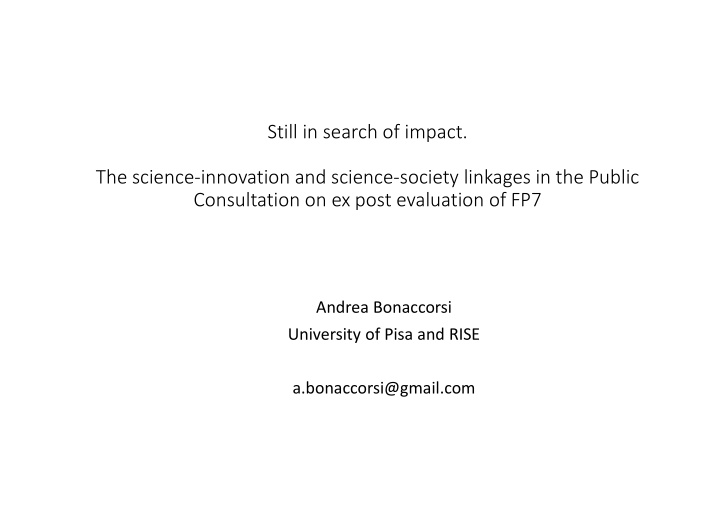



Still in search of impact. The science-innovation and science-society linkages in the Public Consultation on ex post evaluation of FP7 Andrea Bonaccorsi University of Pisa and RISE a.bonaccorsi@gmail.com
Introduction From the Executive Summary of the consultation (p. 4) At the same time there were some shortcomings: • Administrative burden was high and financial and legal rules were cumbersome • Societal impact was not addressed to a sufficient extent • Perception of sometimes narrow topics and of difficulty to enter for newcomers: Game of big entities who know how the system works
Remark # 1 The four programmes ( Cooperation , Ideas , People , Capacities ) - articulate the overarching concept of excellence in different directions - are designed to achieve different specific objectives - Networking and cooperation - Investigator-driven excellence - Researcher mobility - Long term capital equipment and capacity building - follow articulated and consistent sets of selection criteria - are overall complementary This result is a turning point in the maturity of research policy, as different goals are pursued by means of different policy instruments and tools, which are consistent among them. This result is confirmed and strenghtened in Horizon 2020. This is a historical milestone. European research policy has been historically inhibited to develop a full scale policy instrumentation by the limitations of the legal framework. This achievement should be placed in the appropriate historical perspective.
In which of the following areas did COOPERATION Specific Programme of FP7 generate most impact? 80 BALANCE BETWEEN 70 EXCELLENCE AND INNOVATION 60 (>70% RESPONDENTS) 50 40 % 30 20 10 0 Economic impact Environmental impact Impact on scientific excellence Impact on Technological or Regional impact Societal impact social innovations Individual Ministries and Funding agencies Organisation HES and REC Organisation Private Organisation SME Overall
In which of the following areas did IDEAS Specific Programme of FP7 generate most impact? 100 > 90% RESPONDENTS ON 90 IMPACT ON SCIENTIFIC EXCELLENCE 80 70 60 50 % 40 30 20 10 0 Economic impact Environmental impact Impact on scientific excellence Impact on Technological or Regional impact Societal impact social innovations Individual Ministries and Funding agencies Organisation HES and REC Organisation Private Organisation SME Overall
In which of the following areas did PEOPLE Specific Programme of FP7 generate most impact? 100 SOCIETAL IMPACT THROUGH THE 90 MOBILITY OF 80 EXCELLENT 70 RESEARCHERS 60 % 50 40 30 20 10 0 Economic impact Environmental impact Impact on scientific Impact on Technological or Regional impact Societal impact excellence social innovations Individual Ministries and Funding agencies Organisation HES and REC Organisation Private Organisation SME Overall
In which of the following areas did CAPACITIES Specific Programme of FP7 generate most impact? 80 MULTIDIMENSIONAL 70 IMPACT OF RESEARCH INFRASTRUCTURES 60 AND CAPACITIES 50 40 % 30 20 10 0 Economic impact Environmental impact Impact on scientific Impact on Technological or Regional impact Societal impact excellence social innovations Individual Ministries and Funding agencies Organisation HES and REC Organisation Private Organisation SME Overall
Remark #2 In search of impact Stylized evidence • Excellent research quality is a necessary condition for valorization and impact • At the same time, intentional valorization activities must be put in place • Scientific excellence and valorization are neither mutually exclusive, nor mutually inclusive (S. de Jong) • These activities generate inevitably tensions ad trade-offs, but they can be managed appropriately at institutional level • In low and medium-tech industries, some service sectors, and cohesion regions, the balance between excellence and relevance may be different
Remark #3 Early involvement of users Academic research is «embryonic» with respect to the need for development and potential applications. Researchers are not necessarily good in understanding - market needs or social needs - willingness to pay of potential customers Involving researchers very early in a dialogue with users increases the ability to identify opportunities for valorization- but: - the dialogue must be backed by appropriate advanced methodologies - must be extended in time and allow mutual learning (no one-shot)
RESEARCHERS ARE GOOD ONLY HERE DESIRABLE FEASIBLE INNOVATION SELLABLE
Remark #4 Mixing communities of practice Academic researchers and industrial researchers share a common background (PhD) and scientific/ technological language. They differ in professional practices (publication vs confidentiality), organizational constraints (academic freedom vs hierarchy), incentives (recognition vs income). They should be mixed together in order to mutually challenge: - regular meetings at European level (not only at project level) - addressing very specific challenges - overcoming organizational affiliations - backed by technology intelligence tools made available by using data mining and advanced semantic techniques
Cross-reference analysis of ERC project keywords and queries on world patent databases 300 Pyrolysis 1800 270 1600 Mineral carbonation 240 1400 210 1200 180 1000 150 800 120 600 400 90 200 60 0 30 0 Directed Enzyme Evolution Solid Oxide Fuel Cell 90 700 80 600 70 60 500 50 400 40 300 30 200 20 100 10 0 0 Source: our elaboration on data kindly provided by Erre Quadro
Recommend
More recommend